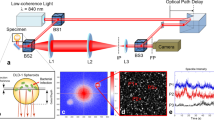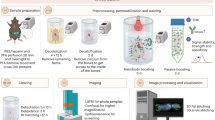Abstract
We describe imaging of green fluorescent protein (GFP)-expressing bacteria from outside intact infected animals. This simple, non-intrusive technique can show in great detail the spatial–temporal behavior of the infectious process. The bacteria, expressing the GFP, are sufficiently bright as to be clearly visible from outside the infected animal and recorded with simple equipment. Introduced bacteria can be whole-body imaged in most mouse organs, including the peritoneal cavity, stomach, small intestine, and colon. This imaging technology affords a powerful approach to visualizing the infection process, determining the tissue specificity of infection, the spatial migration of the infectious agents and the response to antimicrobial agents.
This is a preview of subscription content, access via your institution
Access options
Subscribe to this journal
Receive 12 print issues and online access
$259.00 per year
only $21.58 per issue
Buy this article
- Purchase on Springer Link
- Instant access to full article PDF
Prices may be subject to local taxes which are calculated during checkout







Similar content being viewed by others
References
Zhao, M. et al. Spatial-temporal imaging of bacterial infection and antibiotic response in intact animals. Proc. Natl. Acad. Sci. USA 98, 9814–9818 (2001).
Yu, Y.A. et al. Visualization of tumors and metastases in live animals with bacteria and vaccinia virus encoding light-emitting proteins. Nature Biotech. 22, 313–320 (2004).
Hoffman, R.M. & Yang, M. Color-coded imaging of tumor–host interaction. Nat. Protocols 1, 928–935 (2006).
Hoffman, R.M. The multiple uses of fluorescent proteins to visualize cancer in vivo. Nature Rev. Cancer 5, 796–806 (2005).
Zhao, M. et al. Tumor-targeting bacterial therapy with amino acid auxotrophs of GFP-expressing Salmonella typhimurium. Proc. Natl Acad. Sci USA 102, 755–760 (2005).
Zhao, M. et al. Targeted therapy with a Salmonella typhimurium leucine-arginine auxotroph cures orthotopic human breast tumors in nude mice. Cancer Res. 66, 7647–7652 (2006).
Author information
Authors and Affiliations
Corresponding author
Ethics declarations
Competing interests
R.M.H. is president of AntiCancer Inc. and M.Z. is a Senior Staff Scientist at AntiCancer Inc. AntiCancer Inc. has commercial activities in the area of fluorescent-protein-based imaging and has a Technology Development Agreement with Olympus Corporation.
Rights and permissions
About this article
Cite this article
Hoffman, R., Zhao, M. Whole-body imaging of bacterial infection and antibiotic response. Nat Protoc 1, 2988–2994 (2006). https://doi.org/10.1038/nprot.2006.376
Published:
Issue Date:
DOI: https://doi.org/10.1038/nprot.2006.376
This article is cited by
-
Bacteria-cancer interactions: bacteria-based cancer therapy
Experimental & Molecular Medicine (2019)
-
Engineering of Bacteria for the Visualization of Targeted Delivery of a Cytolytic Anticancer Agent
Molecular Therapy (2013)
-
Bacterial vectors for imaging and cancer gene therapy: a review
Cancer Gene Therapy (2012)
-
Inhibition of Tumor Growth and Metastasis by a Combination of Escherichia coli–mediated Cytolytic Therapy and Radiotherapy
Molecular Therapy (2010)
Comments
By submitting a comment you agree to abide by our Terms and Community Guidelines. If you find something abusive or that does not comply with our terms or guidelines please flag it as inappropriate.



